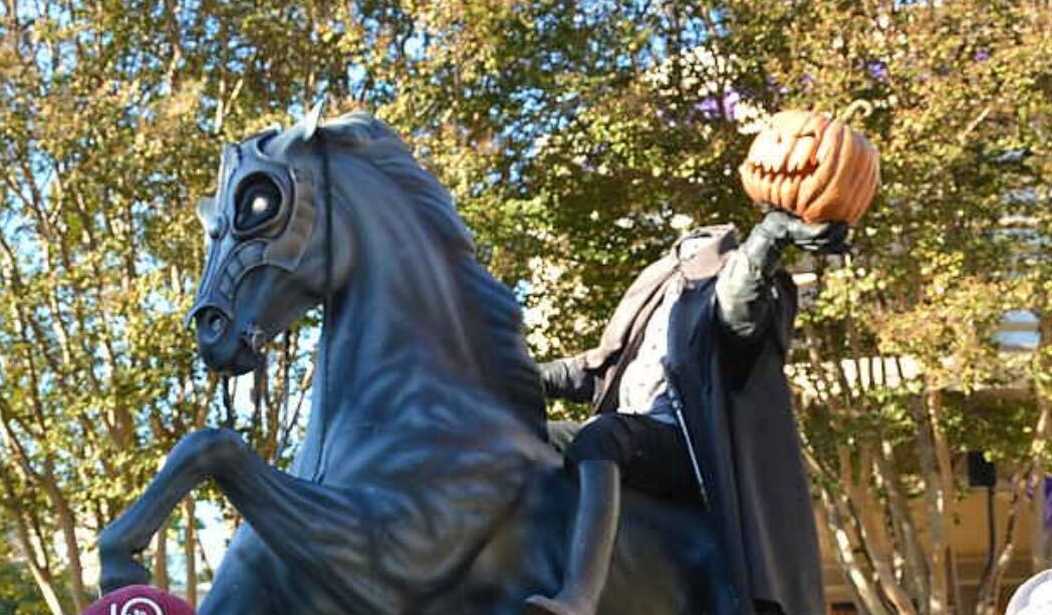Galloping out of the New York woods and bursting from an English mansion’s dank walls came two of the most iconic ghosts in modern literature.
The Headless Horseman needed a head, and the ghost of Canterville Chase needed a child’s tears. And both starred in ghost stories presenting a wondrous blend of fact and fiction, history and fantasy, satire and horror, all culminating in unforgettable climaxes that will haunt you forever. When it comes to spinning a ghoulish yarn, there’s no one to beat America’s Washington Irving and Ireland’s Oscar Wilde.
“The Legend of Sleepy Hollow” is a blend of Old World Dutch superstition and New World Yankee history. The “galloping Hessian of the Hollow” is in fact based on a real person. The New-York Historical Society quotes Revolutionary War Maj. Gen. William Heath’s memoir: “A shot from the American cannon at this place [White Plains, New York] took off the head of a Hessian artillery man.” That’s almost exactly how Irving described the Headless Horseman:
[It is] the ghost of a Hessian trooper, whose head had been carried away by a cannon-ball, in some nameless battle during the [R]evolutionary war; and who is ever and anon seen by the country folk, hurrying along in the gloom of night, as if on the wings of the wind…he sometimes passes along the Hollow, like a midnight blast.
In Irving’s story, one man is particularly afraid of the ghostly and ghastly Hessian: Ichabod Crane, a Yankee schoolmaster and obsessive consumer of ghost stories. From Cotton Mather’s lectures on witchcraft to Tarrytown Dutch matrons’ haunted tales of the hanged British spy John Andre and the Hessian trooper, Crane works himself into a prime state, ready to be frightened out of his wits. And that is exactly what Brom Bones, Crane’s rival for the hand of the wealthy and beautiful Katrina Van Tassel, aims to do with his horrifying account of meeting the Headless Horseman.
Leaving a Van Tassel party with Brom’s warnings and Katrina’s rejection ringing in his ears, the disconsolate schoolmaster soon falls in with the very figure of his worst nightmares, the Headless Horseman. Massive, powerful, and with his head riding on the saddle pommel instead of his neck, the Headless Horseman throws Crane and his old horse into a fever of terror. Crane somehow manages to dash across the bridge, which is supposed to be the boundary of the Horseman’s territory, but is pursued by a blood-chilling missile in the form of the Horsemen‘s head. And from that day onward, Ichabod Crane is never seen in Tarrytown again. Like the Horseman, he had mysteriously vanished.
For Our VIPs: Sanctuary Policies Mean Political and Societal Vampirism
Wilde’s tale, though set in very different surroundings, also has a lovely American girl as the heroine — though Virginia Otis, unlike Katrina, saves the day rather than triggering the climactic crisis. The American Otis family arrives in England and at Canterville Chase after Hiram, the father, is appointed U.S. minister to that country. And whereas the Hessian of the Hollow terrified Icabod Crane, the ghost of Sir Simon de Canterville finds himself terrified and beset by the well-intentioned but persistently unalarmed Americans who move into his family abode.
Sir Simon murdered his own wife in 1575, was chained up and starved to death by his wife’s relatives, and, for 300 years afterwards, haunted the house that was his own, driving many a descendent and their noble guests into insanity or suicide. But no matter how bloody, ghastly, or blood-curdling his apparitions, Sir Simon simply cannot succeed in frightening the American couple and their four children for even a moment.
Patrick Stewart and Charles Laughton as the Canterville Ghost pic.twitter.com/p54NngcudZ
— Catherine Salgado (@CatSalgado32) October 31, 2025
Hiram Otis and his wife kindly offer Sir Simon infallible American remedies for his cold and his rusty chains, their son Washington rubs away the stain of Lady Eleanore’s blood as often as the ghost renews it, and the twin boys in particular are never so delighted as when they are play-acting as spooks and attacking the hapless ghost. At last, little Virginia finds Sir Simon as gloomy as the grave and in near despair, and after reading him an innocent lecture on the wickedness of his ways, Virginia so impresses Sir Simon that he asks for her help. There is a prophecy:
When a golden girl can win
Prayer from out the lips of sin,
When the barren almond bears,
And a little child gives away its tears,
Then shall all the house be still
And peace come to Canterville.
If Virginia pleads with the angel of death on behalf of Sir Simon, and shows by her tears that she has moved even him to repentance, he will be allowed to die truly at last and pass to eternal life. Virginia is missing for many hours, much to the alarm of her family and youthful suitor, the Duke of Cheshire, but when she returns is able to assure her family serenely that Sir Simon is forgiven by God and will never trouble them anymore.
Wilde’s tale is a captivating combination of satirical comedy, bloodthirsty horror, and spiritual redemption. It is, in fact, in its spiritual message particularly appropriate for Halloween since today’s holiday, All Hallows’ Eve, is the vigil before the feast of All Saints (hallows), honoring those who have died but who by their virtuous lives merited eternal joy.
So don’t be afraid to enjoy a literary excursion to Tarrytown or Canterville Chase on this All Hallows’ Eve!
Editor’s Note: Support and follow PJ Media’s latest reporting on President Trump's historic work to restore the rule of law. Join PJ Media VIP and use promo code POTUS47 to get 74% off your membership during our Schumer Shutdown promotion.










Join the conversation as a VIP Member